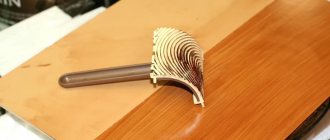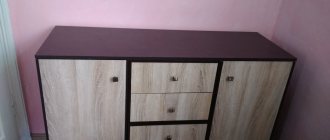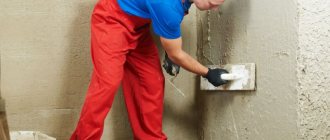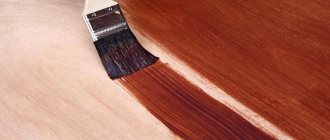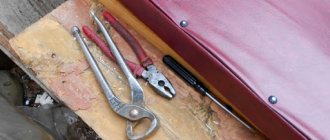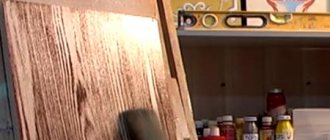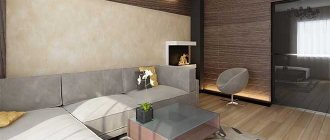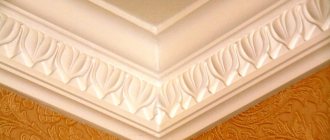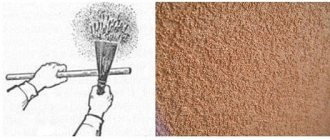Patination of furniture is the process of artificially aging it and creating an antique look. Initially, patina is a natural greenish coating that forms on copper products and indicates its antiquity. People liked this touch of antiquity so much that they figured out how to apply it to wood with their own hands.
In addition to decorative properties, this process also has more practical ones: it extends the service life of old furniture, and protects new furniture from wear and tear.
Industrial patination is quite complex, but there are simpler application technologies that can be used even at home if you have the necessary compositions. To begin with, of course, it’s worth practicing on an inconspicuous area of furniture or even on a separate piece of wood. Having understood how compositions work, you can begin to work on large objects.
What is patination
Not only furniture is patinated, but wooden doors, windows, picture frames and even floors. Kitchen facades, dining areas and bedroom sets are also restored in this way. The most common option is white furniture, decorated with patina, in the classic, Provence or Mediterranean style.
Patina can be white, colored, dark and metallic, imitating gold, silver, bronze or copper. Milk paint with gilding is often used on white furniture - this option is the most popular for furniture in a classic style.
In the photo, another popular option is a noble champagne patina on a white background. This solution will also look great in a classic-style room.
Patination as a process is the application of different compounds to the surface of furniture or ordinary wood. The greatest difficulty is presented by corners, recesses and edges - it is difficult to apply the composition to them in an even layer. This is how furniture made from solid hard and even soft wood is processed: oak, birch, pine, beech and others.
If in the natural environment patina appears only on furniture made of natural wood, then modern technologies make it possible to age even MDF or chipboard panels.
It is worth understanding that artificial patination is rather a conventional coloring with the aim of giving furniture an antique look. At home, no chemical compounds are used that could change the structure of the wood, so if the result is unsuccessful, the paint can be removed without problems - this, of course, is a plus for beginners. Removing the patina is done with a grinder or sandpaper, as in the following video.
Removing the patina
What is patina and patination?
Natural patina is a film formed as a result of the oxidation of copper that appears on the surface of the metal. If you look at ancient monuments cast from copper, you can see a bluish-green coating. This is the patina that appears naturally under the influence of prolonged contact with air. This film perfectly protects the metal from corrosion. It can be seen on copper-containing alloys: bronze and brass.
In most cases, patina comes in various shades of green, but sometimes you can find a patina of blue, red, gray and even black.
Artificial patina is a coating that looks similar to natural, which is formed as a result of the action of special acids on the material. Patination is widely used in decorating interior items for:
- adding sophistication;
- noble antique appearance;
- increasing resistance to damage.
Artificial patina can be applied not only to metal, but also to any other materials - wood, leather, plaster. Modern formulations allow you to do this even at home. As a result, it is possible to achieve an “age-related” change in the color of the surface, while the internal structures of the material remain completely intact. An artificially aged object is practically no different in appearance from a genuine antique.
Necessary materials
Since the patination process is quite simple, it can be safely done at home. You just need some materials and tools.
There will be several compositions - each requires its own brush. For preliminary surface preparation, sandpaper or a grinding machine is used, depending on the size of the object. A dry rag will be needed to rub the decorative layer in order to age it.
Before patinaing, furniture must be covered with a base decorative layer. This can be stain or acrylic paint. When using acrylic compounds at home, it is better to choose water-based ones: they are easier to work with, and they are just as durable. To improve the quality of work, it is worth purchasing a primer - it will ensure better adhesion of all applied layers to the surface.
Next, the patina itself is applied. The top is varnished for additional protection. It is better to pay attention to matte varnish - it will create the effect of antique furniture.
Tools and materials
Before work, you need to prepare all the necessary consumables - paint with an aging effect (with elements of bronze, silver, gilding), regular paintwork if you plan to repaint the product. Instead of paint, you can use wax, stain, shellac or mastic, depending on the chosen patination option.
Other process components that may be required:
- brushes of different sizes;
- roller (for large surfaces);
- sandpaper;
- primer;
- furniture or metal varnish;
- rags for removing excess paint;
- cotton and foam swabs.
Some craftsmen additionally purchase metal powder if the effect of the paint seems insufficient: it is usually used to artificially age metal fittings. There are also ready-made kits for sale for patination and antique restoration - “Patina Verde Green”, “Patina Gold”, “Idea Patina”. Most of the products included in the kits are suitable for various materials - plaster, metal, wood.
Types of compositions
Previously, artificial aging was a complex process: furniture was placed in rooms with very high humidity, rubbed, scratched and mechanically affected in other ways. Now the process has been made much easier; there are even compositions of different consistencies and types:
- thick - paste for base and top coat. Used to achieve a gilded or light rust effect;
- liquid - varnish for finishing coating. Gives a yellowish tint;
- dyes - necessary to change the shade of furniture. For solid wood, stain is used; for MDF, chipboard, relief or carved furniture, acrylic paint is used.
Next, let's take a closer look at some types of patina compositions.
stain
The simplest and most popular way of processing wood to create an aging effect. The stain penetrates deep into the wood, providing protection from ultraviolet radiation, moisture and pests. The color of the composition may differ and ultimately imitate a different patina of antiques - from gray to green. According to its formula, stain is divided into the following types:
- water-based - used when you want to emphasize the structure of the wood, as it lifts the wood fibers, making it more noticeable. Gives the surface a shade of valuable wood, does not require a solvent;
- alcohol - useful for its antiseptic properties, which extend the life of the tree, preventing fungus from developing in it. This stain is based on a dye in ethanol, so to achieve a decorative effect you need to work quickly - the mixture dries quickly. Most often used in the form of a spray or cans, and on small surfaces;
- oil - has an easy application and an even coating, does not lift the wood fibers, and therefore only emphasizes its pattern. Beginners often have a question about how to dilute oil stain - regular white spirit will help.
Wood stain is a self-sufficient decor. It is rarely combined with the application of gold, silver patina or craquelure. Also, this composition is not suitable for processing MDF or chipboard.
An example of work can be seen in the video.
How to make a dressing room mirror? We cover it with stain and silver to create a patina. Old wood effect
Wax
Wax is a convenient material. It is most often used as a finishing coat in the form of a water-based paste wax or a vintage finishing wax. Paints based on it dry for a long time and are easy to rub, so they are used when working with embossed and textured surfaces. They can be used even on unpainted, unprimed wood - this will highlight its structure and provide protection from moisture.
A paste is formed by mixing natural wax and metallic pigment. This mixture gives good adhesion even to the plastic of the MDF panel, so it can be used on wood without a primer. With the help of paste, furniture acquires the effect of gilding, bronze or silver coating.
There are also colorless wax compositions. They are necessary to give the surface a pearlescent tint and repair furniture. It is easy to work with this composition: you need to apply it to the surface and rub in well, then polish the area and remove the excess. After a day, the coating will dry and the furniture can be used for its intended purpose.
Acrylic
Acrylic is suitable for patination of almost any surface: from solid wood to plastic on MDF.
The advantage of acrylic paints is their versatility: they can come in different colors or with different effects, such as rust, fading or darkening. Acrylic works both on the entire surface and only on protruding relief elements of furniture decor. For this purpose, a card with gilding or a darkening effect is often used.
In addition to the usual application of paint, there is another method of patination with acrylic. After applying and drying the composition, the surface is rubbed with sandpaper, creating abrasions that supposedly arise from time. Afterwards the furniture is varnished.
Popular options for acrylic paint patina:
- white;
- golden;
- silver;
- blue;
- black.
Usually, when choosing a patina color for painting, they are guided by the surrounding environment and fittings, for example, the handles of kitchen facades.
Bitumen
The basis of bitumen is concrete polymer. The solvent in its formula can be turpentine, white spirit or water. The resulting mixture has a special consistency, which greatly simplifies application.
Bitumen is necessary to give effects when patination, painting or aging. The technology requires careful application to the wood with a brush or cotton swab. Afterwards - accelerated drying with a hairdryer or long-term drying (about 6 hours) at room temperature.
Often bitumen patina is used for decoupage.
There is also a wax-based bitumen patina. It is necessary to remove excess shine when gilding furniture. Apply it with a cotton swab, the resulting layer dries within 20 hours.
Patination
Nowadays, patination is actively used in the production and restoration of furniture, and both natural wood and the more common MDF panels can be aged. Furniture with a patina can look very rich without actually being expensive. Looking at such interior items, many people think that they see in front of them an ancient set that served some noble family for many years. But in fact, these cabinets were made at the factory just yesterday.
Furniture with patina can look very rich
Creamy caramel color scheme with bright splashes
The option with patinated furniture is suitable for those who really love antiquity, but cannot afford to spend fabulous money on good and high-quality antique furniture. Most often, the patina option is used to decorate rooms in the Provence style.
The mirror takes center stage here, but check out the stunning triple table
By the way, some owners of new furniture can age the interior items themselves by patination themselves at home. This technology is not complicated, but it is labor-intensive, but if you want, you can do everything yourself.
Scandinavian style patina
Patination technology involves applying acrylic or other paint to the furniture façade and then grouting it. After that, it is enough to coat the furniture with a special composition (varnish) so that it acquires a matte shine and remains protected from external influences.
Looking at this authentic bureau, it is unclear whether it has aged naturally or artificially
Boudoir bathroom in a country house
Applying patina yourself
It is advisable to carry out patination work in the fresh air, using protective equipment. First, the necessary furniture or ordinary wood is prepared, and only then the coloring compounds are applied.
Preparation
If you have to work with solid wood furniture, first clean it with sandpaper or a wire brush to remove old varnish and paint. After this, if there is severe damage, they should be repaired with wood putty, dried and sanded again. Then the primer is applied to the wood and left to dry for about 10 hours - the exact time is indicated on the primer package.
The process of preparing laminated furniture for patination is slightly different. First, the surface is also brushed with sandpaper. Then an adhesive insulator is applied, and after it dries, a colorless polyurethane primer is applied.
Patination with stain
Patination with stain is one of the easiest ways to “age” furniture. To do this, a wire brush is passed over the surface of the furniture to remove soft fibers and highlight the texture of the wood.
Afterwards the painting process itself occurs - it can be carried out in different ways:
- sponge;
- brush;
- roller;
- spray.
There are several secrets for working with stain for more uniform coloring:
- simple - you need to wet the furniture with warm water, wipe with a dry cloth to remove excess. Then you can apply the composition;
- difficult - saturate the wood with a special conditioner. It is applied every 20 minutes until it stops being absorbed. After this point, you need to wait half an hour and only then apply paint.
The stain must be applied in two layers. Next, you can apply a metallic patina to the raised relief surfaces. The resulting result is secured with wax or shellac.
Classic way
This method is suitable not only for solid wood, but also for MDF or LSDP furniture.
Article on the topic: Patination of MDF facades in 7 steps >>>
In short, the sequence of actions is as follows:
- Apply the first layer of acrylic paint. There are no specific requirements for how to apply it correctly - you can make neat or, conversely, rough strokes. Leave for a day until dry.
- Rub off a thin layer of paint with sandpaper to create an antique effect. Polish with a rag.
- Apply a second layer of acrylic paint. It may be the same as the first one, different or have a metallic sheen. This layer should be thin, so it should be blended well. If desired, you can sand it with sandpaper. Leave for a day until dry.
- Cover with matte acrylic varnish and leave for half a day until dry.
Such simple steps will give your furniture a sophisticated and elegant look.
Craquelure
Craquelure is an unusual patination technique that results in furniture covered with a web of small cracks. There are several ways to create this effect.
Faceted varnish is the simplest of them. This is a special water-based mixture that cracks when dried. The more layers of this composition you apply, the more cracks you will get. Faceted varnish can be either transparent or colored: it can be applied to painted or untreated furniture - working with this type of patina is very convenient, which is reflected in its cost.
There is another way to achieve cracks on the surface of furniture - alternately layering paint and varnish. First, the furniture is painted with acrylic paint and allowed to dry, then craquelure varnish and matte water-based paint are applied. Then follows the finishing coat, which must be very thin so as not to hide the structure of the cracks that have appeared.
There is also a so-called two-phase craquelure patination technology. For this you need to apply shellac varnish in 2-3 layers, drying each one well. Then the surface is covered with craquelure varnish, after it dries, the resulting cracks are rubbed with bitumen wax and the entire furniture is covered with shellac. This technology makes cracks more noticeable, but less noticeable in structure.
Patination wax how to use
Bituminous varnish, acrylic, and wax are applied quite simply. The compositions are applied with a brush. You can apply it with a sponge or cloth, wiping off the protruding parts, so the patina will remain only in the recesses. You can, on the contrary, apply only to protruding parts with a dry brush. Excess is removed with rags.
If necessary, after drying, apply a second or third layer. Shading is in progress. The dried surface is treated with fine sandpaper. Shellac varnish is applied on top. To create the effect of an old oak surface, stain is used. Water stain is applied to the brushed surface. To highlight the relief, remove excess paint with a sponge. A white spirit-based fixing compound is applied on top.
To remove the texture, wax is applied to the surface with the stain applied. Everything is fixed on top with shellac. A more expensive finish is craquelure. It uses patina and beveled varnish. First, bevel varnish is applied in two layers; when it dries, you can begin patination.
We recommend reading: Waxing laminate flooring
Sets
If you don’t want to understand different methods yourself and look for the necessary materials, you can purchase a ready-made set. They are sold in hardware stores and are intended for do-it-yourself antique restoration.
They are sold under the names “Patina” or “Patinating Set”. Thanks to them, you can achieve different effects:
- antique gilding;
- abrasions;
- cracks;
- natural green patina on wood or copper.
Most often, the sets are universal and suitable for any surface: wood, metal and even plaster. More detailed information can be found on the packaging.
Different patination methods allow you to give furniture a variety of decorative effects: from aristocratic classics to cozy Provence. It’s worth trying several decorating methods to choose the best one for yourself.
Did you like the article? Tell your friends about it:
- 8
- 4
- 3
Features of patination technology
The definition of “patina” originally characterized the appearance on products made of copper and its alloys of a thin film of oxides, which gave the item an “aged” appearance. Modern patination technology makes it possible to age wooden surfaces, furniture elements and products in general, which significantly increases their decorative value.
Industrial patination technology is quite complex, but there are simplified aging methods that, with available reagents and certain skills of an amateur chemist and restorer, will give objects an antique look.
In order not to spoil the furniture product, before patination it is necessary to test the chosen method on a piece of wood.
The simplest and safest way to age furniture is to rub dark wax into its surface. This gives it a natural appearance, associated not with careless care, but with time, contamination.
To increase the decorativeness and naturalness of aging, many restorers use ordinary paints that match the color, “diluting” them with bronze or aluminum powder (powder). All these materials can be found in construction and finishing accessories stores. In addition, special patination kits have recently appeared on sale, which include not only coloring and decorating compositions, but also the tools necessary to perform the operation.
On a note! In addition to metal powder, you will need sandpaper of varying abrasiveness, cotton or foam swabs, and for aging large wooden surfaces - a paint roller.
It should be borne in mind that home patination is essentially a conventional coloring, in which, instead of standard paints, special compounds are used that do not change the structure of the wood, actually aging it, but only give the product an antique look. This coating, in case of an unsuccessful experiment or if you don’t like the appearance, can be easily removed from the surface of the object without causing significant harm.
Most often, experiments on artificial aging are carried out in relation to furniture. To do this, you can use chairs, tables, chests of drawers, cabinets that have lost their visual appeal, and their design does not meet the requirements of the time.
From quite strong, functionally suitable furniture products, you can create the interior of a living space or kitchen in one of the retro styles. In addition to the applied tasks of increasing decorativeness, the restoration technology under consideration also pursues practical goals. The applied new paint layer will not only change the appearance of furniture items, but will also additionally protect the surface from adverse external influences.
Types of patina
An artificially created patina appears many times faster than a natural one. This is all explained by the rapid occurrence of chemical reactions that result from the action of certain chemicals on the surface of an object. In this way, you can imitate various shades - from golden to black, and sometimes you even manage to create a unique unnatural color combination.
Patination of furniture
Now there are 4 main types of patina. Let's take a closer look at them.
Table. Types of patina.
| View | Description |
| Liquid | This patina can be achieved using a special varnish called “patina”. It gives the product a yellowish tint. As a rule, it is used by artists who want to give their canvas a little aged look. When working with wood, this varnish is used at the completion stage. |
| Thick | The compositions that are used in this case have the consistency of a paste, usually two-component. Often sold as a set with a finishing patina and base. You can achieve the effects of gilding, rust, etc. A very common look. |
| Water based | This is something akin to paint, which is applied in various ways to the surface of the product. Suitable for many materials, including wood and metal, also used for aging ceramics. The work must be completed before the patina dries. As a rule, only 4 color options are produced - black, white, rust and green. |
| Faceted varnish | When dried, this substance can crack beautifully, creating a craquelure effect. The more layers of varnish applied to a product, the more cracks will form on it. The color range of the varnish is very rich. |
Artificially aged furniture in Provence style
stain
- this is a material that makes wood look like stained wood, that is, it gives a shade to the wood itself, impregnating its fibers. After tinting with stain, the color of the wood becomes saturated and the texture becomes pronounced. The stain does not create a continuous varnish film on the surface of the wood. Two types of stains are widely used: texture-emphasizing and leveling (sometimes the term “harmonizing” is used).
Emphasizing stains
- This is a classic type of stain that provides deep impregnation. Such stains are solutions of dyes and do not contain binders or resins intended to fix dyes on wood. Dissolved dyes penetrate the wood together with the carrier solvents and are retained in microcapillaries, microcavities about hundredths of a micron in size. Thus, highlighting stains provide volumetric rather than superficial coloring of wood, without veiling the texture, without a grayish tint, which sometimes occurs when binder resins are present in the composition. Of course, areas of the wood grain that are more absorbent, the early layers of growth rings absorb more stain and acquire a richer color. The tone of such areas becomes darker. Emphasizing stains reveal not only the structure of annual rings and flakes, but also visually highlight individual fibers on the surface of the wood.
When emphasized moderately under a silky clear varnish, wood with an accentuating stain can shine with an inner light. This tinting looks most natural on species that do not have a pronounced color texture, for example, on birch or on poorly absorbent species (oak, ash). The effect of emphasizing texture depends largely on the thinner used to dilute the stain concentrate to the desired color intensity, and on the technique of applying the stain. Diluting the stain with a slow thinner, applying it with pneumatic spray with a too “wet” torch, and even on wood with high absorbency, can lead to excessive emphasis. As a rule, the so-called negative effect is considered undesirable, in which the initially lighter areas of the early wood of the growth rings become darker.
In Russia, alcohol-based highlighting stains are of greatest practical interest, but water-borne stains also have a certain area of application. This is the tinting of assembled furniture, most often chairs, using the dipping method. This method, compared to pneumatic spraying, provides greater efficiency, uniformity and tone reproducibility. Diluting the stain with a special water-borne binder allows you to achieve a moderate highlighting effect without smudges.
Leveling (harmonizing) stains
- this is a type of tinting composition, when applied, a decorative effect is obtained, intermediate between the results of using emphasizing stains and stains. Coloring when using such compositions is ensured by insoluble pigments, the scales of which do not penetrate deep into the wood along with solvents, but remain mainly in the surface layer and are fixed with the help of binding resins, which are necessarily included in the composition of leveling stains. NC resins are usually used as binders in spiro-based stains. However, stains of this type also do not form a continuous varnish film. As with highlighting stains, the development or concealment of texture (the leveling effect) largely depends on the rate of evaporation of the thinner and the technique of applying the stain. Typically, leveling stains are diluted with quick thinners. For maximum leveling, such stains should be applied with a dry torch.
On furniture facades made of several parts with multidirectional stains, the use of leveling stains makes it possible to achieve an appropriate harmonizing effect.
Stains
Stains - this word has been known to many since childhood and is mainly associated with a certain liquid in bottles. Stains are used for tinting, that is, adding color to wood or veneer, followed by painting with varnish. Stains contain few resins and impregnate the surface layer of wood, emphasizing its texture.
A good stain should give the wood the desired shade, even out its color and protect it from fading. Some types of stains also provide deep impregnation of wood.
There are several types of stains that differ in properties:
- stains obtained by dissolving dyes
- stains in the form of a dispersion of small drops of colored pigments. Dispersions are when a substance does not dissolve, but is present in the form of small drops in solution.
Also, stains are divided based on binders:
- nitrocellulose binders based on organic solvents
- waterborne acrylic resins
The above differences in stains must be taken into account when working.
Application of stains based on soluble dyes.
When working with stains based on soluble dyes, keep in mind that these dyes are absorbed into the wood along with solvents (there are no binding resins in the formulation of such stains) and take the place of air in the microscopic pores that penetrate the wood. At the same time, the color of the wood becomes more saturated, and the volume of the wood texture appears.
In areas of wood where there is increased absorption, more dyes are concentrated, these areas acquire a darker shade. These are stains with an emphasizing effect.
Stains based on soluble dyes produce colors that are closest to natural wood colors, but it is difficult to obtain rich and pastel colors (for example, pink, green) with their help. This is due to the fact that a significant part of the dyes goes deep into the wood.
The depth of impregnation of wood with stains depends on the thinner used (the slower, the deeper), as well as on the type of wood. Softwood can absorb highlighting stains to a depth of a millimeter or more, so shallow scratches may not be noticeable.
Application of stains in the form of a dye dispersion.
Stains with insoluble pigments, in contrast to the first ones, have a color leveling effect.
The leveling effect is due to the fact that the flakes of insoluble pigments are not absorbed deep into the wood along with the solvent (do not pass through microcapillaries), but remain mainly on the surface and are fixed with the help of binder resins, which are necessarily included in the formulation of leveling stains.
With the help of such stains, the problem of different shades of parts can also be solved, at least partially.
These stains, as a result of a higher concentration of dyes on the surface, can produce brighter, more saturated colors of wood species, as well as pastel colors of the main spectrum - blue, pink, green. Particularly bright and uniform colors can be achieved using water-based stain dispersions.
Stains based on organic solvents.
Stains based on organic solvents dry very quickly (1-10 minutes; as a rule, white stains take the longest to dry), so subsequent layers of paint and varnish can be applied in a very short time. Stains are not recommended for use on products exposed to atmospheric conditions. Special water impregnations have been developed for this purpose.
Glazes
Glaze is an unusual tinting composition: in terms of the number of binders it is similar to stain, but the result of its use is closer to what is obtained when using highlighting stains. Using glaze you can achieve a unique effect of aged wood with dark pores. The emphasizing of pores turns out to be more moderate than after applying a decapé patina, but they are developed more evenly. To achieve a similar effect, after application the glaze is rubbed along the grain of the wood. At the same time, excess is removed and the pores are filled. After rubbing, the color structure of the wood surface is enriched, various halftones and “speckles” appear.
Glazes are diluted with slow thinners (drying - 2-3 hours), in order to ensure the possibility of rubbing after application. Disseminated-vascular rocks acquire an “antique” appearance, and tangential sections of annular-vascular rocks are graphically emphasized.
Technology Notes:
In the practice of tinting wood with a transparent finish, there are many ways to repeatedly apply tinting compounds in one finishing system. For example, to obtain the maximum leveling effect on variegated oak, stain is applied first to the wood and then to sanded colorless primer. When finishing complex products such as chairs, which are difficult to tint evenly, the stain applied to the wood is added to the varnish (1–2%).
When applying alcohol-based stains to oak using pneumatic spraying, it is difficult to ensure complete coloring deep into the pores. This is especially noticeable if the tone is dark. Water-borne stains penetrate pores much better. A compromise option would be to use a universal stain, diluted half with water and half with alcohol thinners.
Modern tinting materials allow you to achieve any desired degree of manifestation of wood texture - from a translucent plastic effect to a bright highlight.
Patina
Patina is quite an exotic product for the common man. In construction supermarkets, they usually sell adapted compositions taking into account household use, and it is seriously different from the patina that is used in production conditions.
What is this paint and varnish material used for? And a patina is needed to give a decorative effect, the so-called antiquity effect. When applying patina, darkness is created in the corners of the facades, in some cases the wood texture stands out.
There are two types of patina, as well as two types of stains:
- solvent-based patina
- patina on water
In factory conditions, the patina is applied using a spray gun. The patina is initially applied in a thin layer to a large surface, and the excess is removed. To ensure that the patina can be easily removed after application, this material initially has reduced adhesion. This interesting word adhesion means the adhesion of a finishing material to the surface on which it is applied.
To obtain darkness in the corners, the patina is sometimes applied locally with a spray gun with a very narrowed spray.
You can try to apply patina with a brush, but it will turn out rude and unprofessional.
Removing excess patina.
Okay, the patina has been applied, how can I remove it? Excess patina is usually removed with Scotch Brite or steel wool. These are mildly abrasive grinding materials that remove patina, but do not scratch the surface of the facade.
By the way, if you apply a thick layer of patina or dry the patina for a long time before applying varnish, then there is a possibility of weak adhesion of the applied varnish over the patina. Poor adhesion means that over time the varnish will peel off along with the patina. The result will not be decorative, but rather disfiguring.
Diluting the patina.
To dilute patina with solvents, use special quick thinners, acetone, ethyl or isopropyl alcohol (when using alcohol or acetone as a solvent, you must be sure of their purity. You cannot apply patina in the “wet-on-wet” mode, as it is difficult to clean off later It is also advisable to apply the patina with a fairly dry torch in one pass of the gun.
Many solvent-based patina tones are available: primary colors, wood colors, gold. You can mix them and also add some stains. Solvent-based patinas are not recommended to be applied to water-based paints and varnishes.
Patina of metallic colors (gold, silver) must be filtered before application.
Patina on the water.
Patina on water differs from patina on solvents in that it has a larger dry residue, increased brightness, and hiding power (that is, opacity). By graphically emphasizing the texture, a more vibrant effect is achieved with a water-based patina.
Drying time for waterborne patina is 30-40 minutes. There are several colors of water-based patinas; the neutral version can be tinted with the same pigment pastes as water-based enamels.
Special effects
Decorative paint and varnish special effects are designed to embellish, embellish and exclusively highlight the beauty of products made from both natural wood and MDF. Below we will look at some of the huge number of possible special effects.
The Decape effect is used to artificially age furniture by releasing wood pores into a patina. On wood species without a porous texture, light brushing is used to create a decapé effect.
Brushing (eng. Brush - brush) is not exactly a paint and varnish special effect, but nevertheless, it consists of scraping soft fibers from the surface of the wood, due to this a relief texture is obtained. When applying patina and then wiping it off, the patina remains in the formed pores and hollows, producing the effect of artificial aging. On oak or ash wood with natural pores, the aging effect is obtained without brushing. Afterwards the surface is varnished.
The Starry Sky effect speaks for itself. This is enamel with metallic glitter, finished with a layer of acrylic varnish.
The Cracolet effect or Craquelure (French craquelure) is the cracking of a layer of varnish or paint on works of art. Colorless one-component composition, with the possibility of tinting in any color. Apply to nitrocellulose primer. The size of the cracks depends on the thickness of the layer of composition applied to the surface. For brighter effects, crackle is combined with patina. It is fixed with a finishing layer of acrylic or PU varnish on a still wet surface.
Metallic effect (primary colors gold, platinum, bronze, aluminum) are enamels with a pronounced metallic sheen. It is possible to reproduce metallic colors according to the RAL catalogue. Acrylic varnish is used for the final layer.
Mother of Pearl effect. This is a transparent finish with a pearlescent shimmer. Applied to enamels of various colors. The top is coated with transparent acrylic glossy varnish.
Chameleon effect. This special effect changes color, smoothly flowing from one to another, depending on the viewing angle. For a more pronounced effect, it is better to apply on a dark base. Transparent acrylic gloss varnish is applied on top.
Our company offers paint and varnish products for wood processing on the Russian market. The company produces a wide range of paints and varnishes in all industry segments, including for professional wood processing.
Stains, glazes, patinas and special effects offered by our company are represented by a series of solvent stains ELM***, a series of glazes P***, and a series of patinas and special effects CH***A and JYS***, as well as in a binder for waterborne patinas NHB02A.
Pavel Usovik 02/02/2016
Patination of wood
This process refers to a method of aging wood in order to visually give it age. The technique is actively used in classic and rustic kitchen interiors, since in these cases it is assumed that furniture and other household items have been in use for a very long time.
The technology of the methods is different, but the goal is the same - to give wood or wood material a coating that forms on the solid wood during a long period of use. Moreover, this coating occurs when the furniture is cared for, and not just used, and therefore is so highly valued from an aesthetic point of view.
At home, reproducing patina on wood or metal is not that difficult. Our master class offers many options that can actually be done with your own hands.
You can use wax, bitumen, and acrylic patina - depending on the future type of the product, your own skill and the nature of the material.
It is worth immediately noting that different methods are usually used to patina metal and wood, although there are exceptions.
- Stain is the most common composition for giving wood a darker, noble shade. The stain is combined with preliminary brushing (removing soft wood fibers) and treatment with shellac primer or antique wax. The method is perfect for doing at home, but limits the choice to a natural range of colors: the colors of silver, gold, and brass are not allowed here. For MDF and chipboard boards, any master class does not allow the use of this method.
- Bituminous patina - it can be applied with a regular sponge and washed with white alcohol. The bituminous composition is easily absorbed into the pores, revealing the wood structure and aging the wood. The result must be sealed with varnish, preferably shellac. This method is not suitable for patination on metal.
- Acrylic patina is a universal product and is suitable for processing wood, metal, and plaster. Acrylic patina paint can have any color, including the fashionable shade of silver and gold. It is applied both to the entire surface - smooth facades, and to threads or convexities. Acrylic paint is most often combined to provide a contrast between a dark natural color and an “aged” one: for example, oak and gold, white oak and silver, walnut and red gold, and so on.
Acrylic paint can be mixed and applied layer by layer, creating very complex visual effects: appropriate recommendations can always be obtained from a master class on the forums. In addition, acrylic paint can be perfectly combined with decoupage, varnishing, painting and other methods of decoration.
- Wax patina provides not only the effect of antiquity, but also the most beautiful tints of color, including metal ones - silver, brass, bronze. Moreover, this effect is obtained on wood. The wax patina is ideal for highlighting carvings, cures slowly and is very convenient for any DIY project. Any master class recommends using a wax composition on carved dining room furniture.
- Shellac varnish itself creates a yellowish or reddish-brown tint depending on the number of layers. Sometimes this is enough to create an aging effect, especially in combination with decoupage. However, almost any master class suggests using shellac varnish as a finishing or intermediate coating not only for decoupage, but also for painting.
- Oil patina - any master class recommends using the composition for both wood and metal. Its properties resemble wax and also hardens slowly. It cannot be used in the classical decoupage technique, since the oil patina dissolves the paper.
Detailed description of the compositions
Kitchen furniture with patina or a cabinet with a gilded frame - any wooden product that has a texture can be treated. It is worth noting that metal and wood are coated with compositions on different bases - they have special characteristics of stability and adhesion to the base.
stain
Almost every home has a patinated wood product. Coating boards with stain is one of the ways to refine products with the option of protection against fungi, mold, moisture penetration and rotting.
To enhance the effect, the working surface is brushed: it is possible to preserve the longitudinal hard fibers, the soft ones are removed with a special hard brush. This is how natural wood is processed at home. True, in this case the patina color is the same - the stain is made in a dark shade, you won’t have to expect gilding.
Bitumen
It would seem that a material far from art is bitumen. But the patina on wood made from it is the most pliable and easy to apply; it can be used to create rich gilding or a thin patina. Bituminous varnish blackens the recesses in the carving, highlighting the edges protruding to the surface. It is made on the basis of bitumen polymer and turpentine or white spirit, therefore, after drying, the treated surface must be secured with shellac varnish.
Acrylic
A universal water-based material for patination of surfaces made of metal, wood, and plaster. It is durable, has good adhesion to substrates, and protects the wood structure from getting wet and colonizing microflora.
The technology of patination of wood does not contain any tricks: you can paint the entire surface or apply color selectively to the protruding parts of the carving. Compositions of different shades are applied in several layers - a complex color pattern is obtained.
Antique acrylic patina can be any color:
- Gold;
- Silver;
- Blue;
- Other possible shades.
Combinations of light and dark colors can give a rich aging effect to noble wood.
Wax
The wax composition leaves a pearlescent shimmer on the surface, which favorably emphasizes the relief of the carving. The coating hardens slowly and is easy to apply without special skills or tools.
Wax paint is non-toxic and safe, which makes it preferable for use in the kitchen. The durability and ability of wax to penetrate the porous surface of wood provides good resistance to humidity and cleaning.
Shellac
Shellac paint-varnish has a reddish-brown or yellowish patina. It helps to preserve the basic color and visible structure of the base if you use shellac as an independent product. In most cases, it is used as a covering layer for other compositions, in decoupage techniques and for painting.
Oil
The oil solution favorably plays up the structure of the wood with rich color. The material is similar to shellac mortar, but it cannot be used in the decoupage technique - the oil does not fix, but dissolves the paper. Used as a coating and protection for less durable paints.
